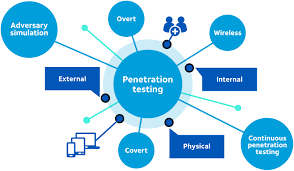Vulnerability Assessment: The Foundation of Cyber Defense
In today’s hyper-related global, cybersecurity is no longer
a luxury but a necessity. The first step to constructing a robust cyber
protection method is carrying out a vulnerability
assessment, a comprehensive procedure that identifies and mitigates
weaknesses in an enterprise’s IT infrastructure. By uncovering those
vulnerabilities, businesses can prioritize remediation efforts, protect
critical assets, and live ahead of ability threats.
What is a Vulnerability Assessment?
A vulnerability evaluation is a systematic assessment of an
organization’s IT ecosystem to identify security weaknesses. These checks
provide an in depth understanding of capacity vulnerabilities, inclusive of:
Unpatched software program and programs
Misconfigured systems and networks
Outdated security protocols
Human errors and insider threats
Unlike penetration testing, which simulates assaults, a
vulnerability assessment specializes in cataloging and prioritizing dangers,
permitting groups to cope with them proactively.
Why is Vulnerability Assessment Essential for Cyber Defense?
1. Early Threat
Detection
By figuring out vulnerabilities earlier than they're
exploited, groups can save you cyberattacks and decrease the risk of records
breaches.
2. Regulatory
Compliance
Regulations which include GDPR, HIPAA, and PCI DSS mandate
everyday vulnerability tests to ensure information protection. Compliance now
not most effective avoids fines however additionally builds consumer trust.
3. Strengthened
Security Posture
A properly-completed vulnerability assessment enables
agencies set up a stable foundation for their cybersecurity strategies,
reducing average hazard.
4. Cost Savings
The value of addressing vulnerabilities through proactive
measures is extensively lower than getting better from a records breach or
ransomware attack.
Key Components of a Vulnerability Assessment
1. Asset Inventory
The first step is to become aware of and record all IT
belongings, which include:
Servers and workstations
Applications and databases
Network devices
Cloud offerings and IoT devices
This inventory guarantees a complete assessment.
2. Vulnerability
Scanning
Automated equipment are used to scan structures and networks
for acknowledged vulnerabilities, such as:
Outdated software program variations
Weak passwords
Open ports
Misconfigured firewalls
3. Risk Analysis and
Prioritization
Each identified vulnerability is classed based totally on:
Likelihood of exploitation
Impact on systems and records
Compliance necessities
This analysis facilitates organizations attention on
addressing the most critical dangers first.
4. Reporting
A distinct file is generated to provide:
A complete list of vulnerabilities
Risk stages for each weakness
Actionable remediation steps
5. Remediation Recommendations
The assessment concludes with tailor-made steerage to mitigate
vulnerabilities, which include patching, reconfiguring systems, and
strengthening policies.
Common Vulnerabilities Identified
1. Unpatched Software
Failure to update software program and applications is one
of the main reasons of records breaches.
Solution: Implement an automated patch control machine to
make sure timely updates.
2. Misconfigured
Security Settings
Improper configurations in firewalls, routers, and different
systems can reveal sensitive records.
Solution: Conduct ordinary configuration opinions and comply
with enterprise fine practices.
3. Weak Passwords
Inadequate password policies create access factors for
attackers.
Solution: Enforce sturdy password requirements and enforce
multi-factor authentication (MFA).
4. Lack of Encryption
Unencrypted facts may be intercepted and exploited with the
aid of cybercriminals.
Solution: Use stop-to-stop encryption for touchy statistics,
both in transit and at relaxation.
5. over-Permissioned
Accounts
Excessive permissions increase the danger of insider threats
and accidental facts exposure.
Solution: Apply the principle of least privilege to restrict
get admission to to touchy systems.
Steps to Conduct a Vulnerability Assessment
1. Define the Scope
Determine the systems, networks, and packages to be
assessed, aligning with commercial enterprise goals and compliance necessities.
2. Perform Scans
Use advanced scanning equipment to pick out recognized
vulnerabilities throughout all scoped assets.
3. Analyze Results
Evaluate the severity and capacity effect of every
vulnerability, specializing in people with the very best danger.
4. Create a
Remediation Plan
Develop a prioritized roadmap for addressing
vulnerabilities, leveraging automation in which possible.
5. Verify and Monitor
Validate that remediation efforts are a success and put into
effect ongoing monitoring to seize new vulnerabilities.
Benefits of Regular Vulnerability Assessments
1. Continuous
Improvement
Regular assessments make certain that new vulnerabilities are
diagnosed and addressed directly.
2. Improved Incident
Response
Knowing your vulnerabilities facilitates groups reply faster
and extra effectively to cyber incidents.
3. Enhanced
Stakeholder Confidence
Demonstrating a proactive method to safety reassures
clients, companions, and regulators.
4. Minimized Attack
Surface
By addressing vulnerabilities, groups reduce the variety of
capability entry factors for attackers.
Choosing the Right Vulnerability Assessment Partner
Selecting a qualified accomplice is critical for conducting
effective tests. Look for:
Proven Expertise: Ensure the issuer has experience in your
enterprise and is certified in cybersecurity requirements.
Comprehensive Tools: Verify that they use superior scanning
tools for thorough evaluations.
Actionable Insights: The accomplice must deliver clean,
realistic suggestions tailor-made in your environment.
Post-Assessment Support: Opt for carriers that assist with
remediation and follow-up checks.
Conclusion
A vulnerability
assessment is the cornerstone of any effective cyber protection
strategy. By identifying and prioritizing security gaps, businesses can take
proactive steps to shield their virtual assets, meet compliance standards, and
construct resilience in opposition to evolving threats. Regular checks empower
organizations to live beforehand of attackers, making sure lengthy-time period
safety and peace of mind.
.jpeg)
.jpeg)

.jpeg)
Comments
Post a Comment